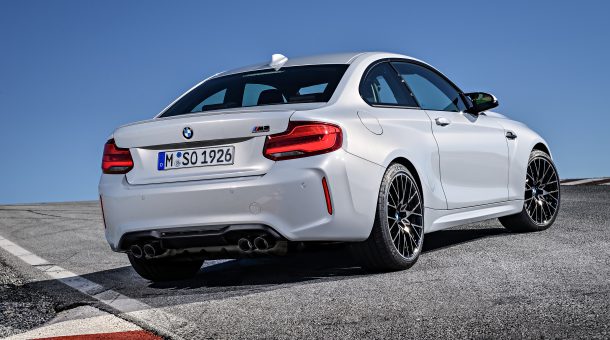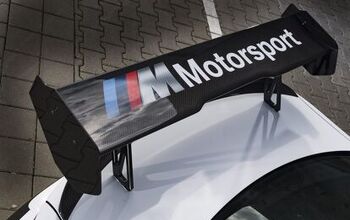BMW Replaces M2 Coupe With 'M2 Competition' This Summer

For a long time BMW was being accused of losing its touch when it came to building the “ultimate driving machine.” People would gripe that the company’s tech was overshadowing driving enjoyment. That may be true to some degree but you could usually point them to the M division and tell them not to worry.
However, most people don’t have the kind of money required to facilitate the purchase of an M3 — and if they don’t have the cash for that, then they definitely aren’t going to pick up the superb M5. But that’s okay because BMW eventually built the M2 and it’s probably the best car in its lineup.
That’s why we are somewhat surprised to learn BMW will be giving the fun-loving coupe a dirt nap, replacing it with the more hardcore “M2 Competition.” It’s not a new car in the strictest sense, but it is a slightly different mindset.
More is more. That’s the theory the M2 Competition works under as it borrows heavily from the M3 and M4, starting with their engine. BMW opted to ditch N55 and replace it with the S55, leaving us with an twin-scroll inline-six of the same displacement and more power. The 3.0-liter now makes 405 horsepower and 406 pound-feet of torque — which is an increase of 40 and 63, respectively.
That shaves off roughly a quarter of a second from the M2’s 0-to-60 time, although the 7-speed dual-clutch automatic is a touch faster than the manual. According to BMW, DTC-equipped models can hit the mark in four seconds flat but the manual takes an additional 0.2 seconds.
The M2 Competition gets a number of chassis improvements to handle the upgraded power, which also appear to be borrowed from the bigger M cars. A carbon fiber strut helps out with front-end stiffness, while aluminum is the new material of choice for control arms and the front and rear axles.
Steering has been “enhanced” but we’re hoping not in the same way as the M3/M4. Both models offer an unpleasant electronic vagueness that takes some time to become accustomed to and is among their biggest drawbacks. We’d like to have seen BMW talk about feedback but instead the improvements made in regard to steering appear to revolve around how it works with speed. It’s electronically adjustable.
You can actually customize most of the car’s settings and assign them as presets, including the engine and transmission, if you have the dual clutch. A slick-sounding electronic limited-slip differential handles power delivery to the rear wheels and bigger M Sport brakes are said to bring the vehicle down to a stop faster than its predecessor.
Aesthetically, it’s not all that different from the outgoing M2 Coupe. However, we’re not convinced all the changes made were wise ones. First of all the seats, which seem very nice, come with an illuminated M2 logo embedded in the backrest. That’s borderline tacky, but whatever. The new 19-inch wheels, wrapped in 254/35-series front and 265/35-series rear tires, only come in various shades of black. You can either have all black or a bi-color design that is still partially blacked out.
The enlarged kidney grille also ditches its chrome for a shade of midnight crude. Can you guess what color the new exhaust tips are? I bet you can.
While the de-chroming of the M2 does give it sort of a track-car vibe we’re sure many will appreciate, it seems strange they wouldn’t offer it as part of an appearance package. In fact, the whole car has a sort of “special edition” feel about it. However, BMW is doing this kind of stuff on all of the M vehicles so it makes sense in a broader context. I just feel that Competition lacks the broader appeal the coupe has. Fortunately, it’ll probably make up for it in performance. We just pray copying the M3/M4 exhaust setup (flaps and all) and styling doesn’t involve copying fake noises being piped in through the audio system.
The 2019 M2 Competition should arrive at BMW dealerships this summer. Pricing has yet to be announced but expect it to surpass the 2018 M2 coupe’s $54,500 base price.
[Images: BMW Group]

A staunch consumer advocate tracking industry trends and regulation. Before joining TTAC, Matt spent a decade working for marketing and research firms based in NYC. Clients included several of the world’s largest automakers, global tire brands, and aftermarket part suppliers. Dissatisfied with the corporate world and resentful of having to wear suits everyday, he pivoted to writing about cars. Since then, that man has become an ardent supporter of the right-to-repair movement, been interviewed on the auto industry by national radio broadcasts, driven more rental cars than anyone ever should, participated in amateur rallying events, and received the requisite minimum training as sanctioned by the SCCA. Handy with a wrench, Matt grew up surrounded by Detroit auto workers and managed to get a pizza delivery job before he was legally eligible. He later found himself driving box trucks through Manhattan, guaranteeing future sympathy for actual truckers. He continues to conduct research pertaining to the automotive sector as an independent contractor and has since moved back to his native Michigan, closer to where the cars are born. A contrarian, Matt claims to prefer understeer — stating that front and all-wheel drive vehicles cater best to his driving style.
More by Matt Posky
Latest Car Reviews
Read moreLatest Product Reviews
Read moreRecent Comments
- Add Lightness ...and I thought the Trump Towers were excessively pretentious.
- Daniel Tons of discounts out there on the eGMP's, just pick your style: Ionic 5/6, Kia EV6 and Genesis GV60. Personally, I got $20k off on a $60k MSRP GT-Line EV6 (only $7500 of that was a "rebate" from the state, the rest was Kia and dealer discounts). They are not only the same platform, but nearly identical mechanically other than slightly adjusted wheelbases. Find this one ugly? Look at Ionic 5 or EV6 instead, it's actually pretty cool how they came up with 4 distinct styles with basically the same car to fit many different tastes.
- Dave Holzman EVs will be ready for prime time when the chargers are dependable, and easy to use, when they can fill the battery in around 10-15 minutes, when there are sufficient numbers of them that people don't have to hang out for a half an hour waiting for a fast charger to be free, when chargers are widely available even in Nebraska, Wyoming, eastern Oregon, Nevada, Utah, the northern parts of Maine, New Hampshire, and Vermont, and within 10 miles of the start of the Tail of the Dragon, and when they get fixed pronto when they have problems.
- MaintenanceCosts The Supercharger network is something with much more growth potential than their actual car building operations, which has been marvelously run to this point and has a years-long head start on all its competitors, and Elon lays the whole team off?I don't know if it's distraction or the drugs, but he is not making good decisions and should not be CEO anymore.
- Dirk Wiggler I drive down the Palisades and near the George Washington Bridge I see FIAT housing complex (apartments, same font as the auto company). Seems like they tout energy/electric efficiency. I always wonder, 'what's that...is it really the same FIAT?'






































Comments
Join the conversation
Glad the V6 Camaro exists. $26k 330HP.
Where in the hell are the other 4 cylinders? In the motor picture above I can visualize 2 cylinders under the plastic cover but the other 4 must be buried in the firewall. If a plug change cost $10,000 on this car, I'd believe it! What a shade tree mechanics nightmare.